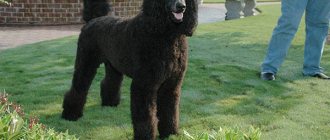Chihuahuas have good health and can safely be called the longest-livers among decorative breeds.
It is impossible to predict exactly how long a pet will live.
However, knowing about the physiological characteristics of the dog and the nuances of proper care, you can extend the life of the pet.
Chihuahuas are distinguished by their sociability, calmness and ability to adapt to new conditions.
They find a common language with all family members, but only one person is recognized as the owner.
Pet character
They are loyal, affectionate, cheerful and active dogs that need care and love to be the center of attention..
Fearless, capable of defending their owner at any moment, they are not only good guards, but also watchmen, wary of strangers, announcing their arrival with a ringing bark.
In the absence of education, they can show disobedience and aggression, so you should start training as early as possible.
They are smart and quickly remember commands, but may refuse to carry them out due to natural stubbornness and willfulness..
Read more about the Chihuahua's personality here.
Diseases
Find out in advance basic information about attacks of hypoglycemia in dogs (causes of occurrence, methods of prevention).
Similar fainting can occur in 80% of puppies with somewhat low weight (up to 650 grams).
Breeders artificially support the body's performance:
- give glucose injections;
- add sweet water to the diet;
- Feeding is carried out at a precise time (often in fractional portions).
They limit the space for keeping puppies (so babies get less tired during active games).
As a rule, mini Chihuahuas are somewhat picky eaters.
This does not indicate poor health: they are simply weak and fragile. Puppies should outgrow this condition by four months of age.
Life expectancy of a standard Chihuahua
Standard Chihuahuas are considered dogs weighing from 1.8 to 3.5 kg .
Based on the results of social surveys, it was established that their life expectancy is on average 12-16 years. Also, according to statistics, females live 2-3 years longer than males, the reason for this has not been established.
The life expectancy of bitches actively participating in breeding work is reduced by several years .
Officially recorded cases of longevity include a male named Megabyte, who died in January 2014, having lived 20 years and 265 days.
Breed Features
Chihuahuas are small dogs, their weight reaches only 3 kg. Despite their compact size, these are very active and inquisitive animals. They enjoy physical activity, walks and games with their owner. The disadvantages of the breed include brittle and brittle bones, which often causes injury and death. Even as an adult, a Chihuahua can get a fracture if it falls from a small height, such as a sofa or stairs. In addition, bone problems often appear during pregnancy and childbirth.
In general, Chihuahuas have a fairly stable psyche, but they can show belligerence and increased activity when their owner is threatened or when meeting other animals. It is important for owners of this breed to teach their pet commands and obedience from puppyhood.
How long do minis live?
The weight of a mini Chihuahua ranges from 600 grams. up to 1.8 kg .
The mini variety is primarily a breeding marriage, which unexpectedly became popular among breeders.
Therefore, despite a predisposition to the same diseases as standard representatives of the breed, minis are more likely to have genetic and anatomical defects that shorten their life.
On average, mini dogs live 8-9 years.
Expert opinion
Kozhevin Semyon Kirillovich
Expert dog handler.
When purchasing a dog, you should not choose the smallest puppy from the litter. Such individuals are likely to have various pathologies. It is important to understand that all data on a dog’s life expectancy are average figures. Exactly how long a pet will live depends largely on the owner and how much quality care he will provide to the dog. You cannot neglect the principles of proper nutrition, visiting a veterinarian, vaccination and other aspects of caring for your Chihuahua.
Diseases
The main ailments to which Chihuahuas are susceptible:
- eye diseases (cataracts, glaucoma, lens clouding, hypersensitivity);
- sudden seizures (seizures lead to loss of consciousness and epilepsy);
- damage to the oral cavity;
- weight loss;
- an increase in temperature above normal;
- vomit;
- dandruff;
- itching and burning;
- damage by small parasites;
- cough;
- loss of appetite or complete refusal to eat;
- intestinal disorders;
- purulent discharge from the ears and nose;
- rapid breathing. The appearance of these symptoms should concern the owner and prompt him to undergo a medical examination with the dog at a veterinary clinic. Only a specialist can make an accurate diagnosis and choose the right treatment.
Age by human standards
| Dog age | Person's age |
| 1 | 15 |
| 2 | 21 |
| 3 | 25 |
| 4 | 29 |
| 5 | 33 |
| 6 | 37 |
| 7 | 41 |
| 8 | 45 |
| 9 | 49 |
| 10 | 53 |
| 11 | 57 |
| 12 | 61 |
| 13 | 65 |
| 14 | 69 |
| 15 | 73 |
| 16 | 77 |
| 17 | 81 |
| 18 | 85 |
| 19 | 89 |
| 20 | 93 |
Kleiber's Law
An attempt to link the correspondence of age with Kleiber’s well-known metabolic law of “three quarters” turned out to be untenable. Recall that Kleiber's law relates basal metabolic rate to body weight and predicts that larger animals should live longer.
In dogs, the relationship by breed is the opposite—small breeds live longer.
At the same time, the validity of Kleiber’s law is not questioned - the law works on warm-blooded animals ranging in size from a mouse to an elephant, and a dog “on average” occupies the place assigned to it by law on this scale.
The age ratio between a person and a dog will vary depending on the breed of the pet. So, 78 human years correspond to:
- 10 years of giant breeds;
- 12 years of large breeds;
- 14 years old medium breeds;
- 15-16 years of small breeds.
This inverse of the general dependence phenomenon within a species is observed in mice, horses and even in people, it is just more pronounced in dogs.
Accordingly, the general rule for the animal world that links life expectancy to heart rate does not work, according to which the heart of an animal makes 1 billion contractions during its life.
Small breeds have a faster heart rate, but they live longer. The weight of a mastiff (80 kg) is 40 times higher than the weight of a chihuahua (2 kg), and according to Kleiber’s law, it should live 2.5 times longer, but in fact it lives 1.5 times less.
The reason is most likely that the concentration of the insulin-like growth factor IGF-1, which, unlike growth hormone, is secreted throughout life and slows programmed cell death, is lower in small breeds than in large breeds. As a result, their aging slows down and the risks of age-related diseases are reduced.
Causes of premature death
Mistakes made during breeding work by incompetent breeders cause the birth of unhealthy puppies - the entire litter or individual individuals.
Unscrupulous breeders do not disclose the Chihuahua puppy’s health problems to potential buyers, while serious illnesses will inevitably lead to the pet’s premature death.
In addition to the presence of incurable pathologies leading to death, the lack of proper care can significantly shorten a pet’s life.
Chihuahuas are fragile dogs, so lack of attention from owners can lead to the animal receiving injuries that are incompatible with life..
The refusal of owners to vaccinate their dog or their desire to save money on this procedure also leads to adverse consequences. Infectious diseases are one of the main causes of early death of a pet.
It requires careful monitoring of the quality of the Chihuahua's diet and the amount of food it consumes - in case of exhaustion, the immune system weakens, and the presence of excess weight affects the functioning of the heart and other internal organs and shortens the animal's life by an average of 5 years.
Briefly about the main thing
- Chihuahua is a decorative breed of dog weighing up to 3 kg. They have a stable psyche, but a number of hereditary diseases. You need to carefully choose a puppy and trust only a trusted breeder.
- Representatives of this breed live on average up to 11-15 years. Life expectancy depends on physiological characteristics, care and maintenance.
- The main causes of death for Chihuahuas are cancer, infectious diseases, injuries and congenital malformations.
- To prolong the life of your pet, it is important to provide it with comfortable living conditions, proper nutrition and regularly undergo preventive veterinary examinations.
Have you ever owned a Chihuahua? In the comments, share what these dogs need for a long and comfortable life.
How to extend the life of a pet?
Before purchasing a puppy, you need to find out about the health of its parents in order to exclude the possibility of hereditary diseases.
In the future, it is necessary to constantly monitor the pet’s health, visiting the veterinarian for routine examinations at least once a year and not neglecting the necessary vaccinations.
You can extend the life of your Chihuahua by avoiding accidents and maintaining good health by adhering to the following recommendations:
- Walk your pet only on a leash or harness;
- socialize the dog to minimize stressful situations;
- Explain to children how to properly handle a Chihuahua so as not to injure it;
- provide the dog with a personal place away from noise, drafts and heating appliances;
- avoid hypothermia and overheating;
- adhere to the principles of proper nutrition;
- eliminate the possibility of contact with infected animals and hazardous household chemicals.
The pet’s lifestyle should be moderately active, which requires regular walks in the fresh air..
Physical activity helps you lose weight, build muscle, strengthen joints and ligaments, strengthen the immune system and avoid the development of many diseases.
Neutered dogs have a longer life expectancy because... This operation minimizes the likelihood of developing testicular and prostate cancer in male dogs and ovarian and mammary cancer in female dogs.
LeBeau theory
In 1953, the French veterinarian A. LeBeau, having examined the stages of growth and development of the body common to humans and animals, developed a theory that takes into account the accelerated development of a puppy at a young age. To do this, he compared:
- age of puberty;
- age of maturity;
- life expectancy.
According to this theory, the first year of a dog’s life is equal to 15 human years, a two-year-old individual corresponds to a 24-year-old person (i.e., the second year of its life is equal to 9 human years), and each subsequent year of life “adds” 4 human years to it.
LeBeau's theory does not take into account the developmental features of animals depending on their size.
Diet
Proper nutrition is the key to Chihuahua health and longevity..
It should be balanced, moderate and nutritious. Dogs of this breed are prone to obesity, so it is important that the food replenishes the pet's energy through quality, not quantity.
If the diet consists of natural products , it should include :
- dietary meat;
- lean sea fish;
- offal;
- eggs;
- buckwheat and rice cereals;
- vegetables, fruits, herbs;
- dairy products.
Add 1 tsp to prepared food. flaxseed or olive oil .
You will also need to take vitamin complexes that support the chihuahua's immunity.
IMPORTANT!
The daily food intake is calculated based on the dog’s weight - 50-80 grams are required per 1 kg of weight. food.
If we are talking about ready-made industrial feeds, then they should be premium, super-premium or holistic - such feeds are made from high-quality ingredients and contain all the necessary vitamins and minerals.
Chihuahua suitable food brands:
- NOW;
- Grandorf;
- Almo Nature;
- Purina Pro Plan;
- Bosch;
- Acana;
- 1st Choice;
- Monge;
- Royal Canin;
- Hills;
- Orijen.
It is worth sticking to the diet and feeding an adult pet twice a day.
You cannot mix natural food and ready-made food, or give your dog food from the common table..
Health
How many years Chihuahua dogs live is directly related to their health. In general, it's not bad. Typical diseases for the breed are: hydrocephalus, diseases of the teeth and oral cavity, hypoglycemia, urolithiasis, cataracts, demodicosis, pulmonary stenosis and some others. The reason for the dog’s special vulnerability is the open fontanelle, as mentioned above.
Therefore, you should not trust her to a child who is not at least six years old, and preferably even eight. In addition to the danger to the health and life of the dog, such a situation can also be negative for the psyche of the child himself, who accidentally injured the animal during active play. The life and health of the pet are literally in the hands of the owner.
Quality maintenance and care
First of all, proper care for a Chihuahua includes:
- proper feeding;
- health monitoring;
- antiparasitic treatment.
Do not forget that Chihuahuas are able to capture the mood of their household, so with a tense atmosphere in the house and frequent scandals, they experience stress, which can provoke the development of diseases and affect life expectancy.
The tendency of this breed to dental diseases necessitates careful oral care : cleaning 2-3 times a week at home and twice a year in a veterinary clinic .
Otherwise, bacteria can enter the bloodstream through the gums and reach the internal organs.
Chihuahuas also require hygienic haircuts, monthly nail trims, daily brushing, eye and ear examinations, and quarterly bathing.
Rules for choosing a puppy
First of all, you need to decide what gender of dog you would like to buy. Males have a playful and curious character, and they also tend to mark territory; girls, on the contrary, are more careful and affectionate.
It is also important to decide for what purpose the dog is getting. Chihuahua puppies intended for participation in exhibitions and breeding will cost more than their pet-class counterparts.
To avoid future problems with your dog’s health, you need to consider the following:
- Activity. The kitten should be playful and curious, even if it has recently woken up.
- A good appetite. A healthy, growing body requires a lot of energy, and if your dog isn't eating enough, it could be a sign of illness.
- Toilet training. A responsible breeder pays a lot of attention to this issue, and the grown-up kittens already know where to do their business. Otherwise, the owner will have to handle the upbringing.
If the animal’s behavior does not cause suspicion, then you can examine the puppy in more detail. Please note:
- On the condition of the ears. Sinks must be clean, free of irritation and rotting.
- Nose. His earlobe, if the puppy is healthy, is wet and there is no discharge.
- Eyes. In a non-sick puppy, they are clean and slightly damp.
- Chihuahua weight. Can range from 500 grams to 2.5 kilograms.
The hairline requires a detailed examination. It should be shiny if it is a short-haired representative of the breed, and thick and silky for long-haired kittens.
And of course, the dog should not have parasites, scratching or irritation.
Caring for an older dog
As Chihuahuas age, they do not require complex changes in care. You should also take care of the coat, claws, teeth, eyes and ears.
The dog should be switched to age-appropriate dry food.
NOTE!
If feeding natural products, you will need to consult a specialist who will prescribe the necessary vitamin complex.
It is necessary to reconsider the walking regime - the dog should go outside, but the duration of the walk should be reduced.
Chihuahuas over 10 years of age must be checked for health twice a year..
Signs of aging
The young Chihuahua is very active. He loves to play and moves a lot. Closer to middle age, the dog becomes calmer. She is no longer so interested in outdoor games. Old age becomes noticeable. Already closer to four years of age, the first gray hair begins to appear on the face. The head and back are turning grey.
There are other signs that the pet has already crossed the threshold of maturity and is approaching old age:
- Character changes. The pet becomes more affectionate or, conversely, more vicious;
- No interest in games. By the age of 3-5 years, a dog completely loses interest in games. She is no longer interested in them;
- Loss of interest in the opposite sex;
- Joint problems. With age they become less mobile. The pet begins to limp, tries to run less, and generally tries to reduce the degree of physical activity;
- Wool quality. Not only does gray hair appear, in some places the hair begins to fall out, and bald spots may even appear. The undercoat becomes less dense.
- Memory problems appear. Memory quality is getting worse. The pet begins to forget commands that he knew well before;
- Hearing and vision deteriorate;
- Age-related diseases appear. The urethra becomes weaker and urinary incontinence may occur.
Dry food size for chihuahua
Dry food for Chihuahuas should be selected from the appropriate category. It should be designed for miniature dogs and have a miniature kibble size. Of course, dry food is suitable for a pet that does not yet have dental problems. If you have problems with chewing, it is better to choose soft canned food or patches.
Do I need to crop my Chihuahua's ears and tail?
Many people who are not familiar with the breed do not even suspect that Chihuahuas have their ears and tail docked. According to the requirements of the standard, such manipulations with ears and tails are not permissible. By nature, the ears should be large and stand on the dog’s head. The tail is erect and slightly curled. Some kennels resort to cosmetic surgery if puppies have defects.
Hygiene
You can extend your pet’s life by following all the rules for caring for its fur and oral health. By the way, it is the second factor that is its weak point. Almost all dogs of this breed suffer from diseases such as caries, tartar deposits and gum disease. A special toothpaste has been developed for the oral hygiene of these babies. It must be cleaned every day, removing plaque that forms after eating.
It is important to monitor the condition of the ears and claws. The ears are cleaned with cotton pads, soaking them in warm boiled water.
Dogs are brushed and bathed more often than cats. When washing, use zoo shampoos with a mild effect. You should not bathe dogs in cold weather or leave them near open windows or in drafty areas after bathing. Wool can be dried with a warm hairdryer.
For combing, special combs are selected that do not injure the skin and correspond to the length of the coat of a particular individual. Nails are trimmed approximately 2 times a month. In order to reduce the duration of the procedure, they use a special device - a nail clipper for small breeds of animals. At the same time, you need to trim the claws little by little so as not to injure the soft tissues. The hair between the paw pads is trimmed.
See below for more information about the characteristics of the breed.
A little history
The Chihuahua dog breed has been sacred for many years and has taken part in religious celebrations and ceremonies.
During the school years the following was shown. Retriever racing does not persist for too long or clearly in the aggression stage. They become chronically ill more quickly, suffering from skin diseases, for example, because lack of sleep weakens the immune system. On the other hand, terrier breeds are longer lasting and more noticeable, and only after quite a long time do they reach the stage of serious illness.
Aggression is not bad behavior. This is a warning, a clear sign that the dog is overexerted. At this point, it is necessary to intervene before irreparable physical damage occurs. Many illnesses can be associated with overburden, as stress weakens the body as a whole. Cancer, allergies, organ failure and nervous disorders also cause breakouts in people.
But, if the owner died, the animal was euthanized and mummified. People thought that this dog took on the sins of its owner, protecting his spirit.
A few years later, dogs were also given “respect.” Dogs not only continued to be buried with their deceased owners, but they also began to be used for food.
Only many years later did the cute little ones find the true love of people.
How much sleep and rest does a dog need?
Adult dogs: from 17 to 20 hours. Puppies, elderly and sick: 20 to 22 hours. This also includes a regular walk in front of the TV. Sometimes clients say that their dog doesn't sleep that much on its own. Well, it must be brought to him, of course, since, as already mentioned, natural calmness remains. It is necessary to establish a ritual of calm. Some dogs are so used to always acting that his man must lie down with him first.
Suitable for housing Read more ▼ ▲. Contrary to popular belief, small dogs are not always suitable for indoor life - many have too much energy or bark in high-rise buildings. Good qualities for a pet dog are to be calm, have little energy, stay inside and be friendly with other residents.
By the beginning of the nineteenth century, the first exhibition was organized in America, in which a baby Chihuahua took part for the first time.
Origin
It is believed that they come from the ancient lands of the North American continent. They first appeared on the Yucatan Peninsula, and some believe that it was among the ancient Mayans. A little later, they came to the Toltec and Aztec tribes, who considered them sacred animals and used them in magical rituals. The Indians firmly believed in the extraordinary abilities of dogs, so each of them had its own servant.
His responsibilities included feeding the animal and carefully caring for it for as long as Chihuahua dogs live. The name of the breed was not given by chance. In the mid-19th century, archaeologists discovered images of dogs carved on huge blocks of stone. This event took place in the Mexican state of Chihuahua, from which the name of the breed was derived. True, in Russian pronunciation it has changed somewhat.
What are they sick with?
Basically they have strong immunity. Only with improper care or deviations in breeding work, acquired or hereditary ailments bother. The fragility of the skeletal system also affects it. So sometimes dislocations or fractures are difficult to avoid.
If you want to be sure that your child will be healthy, take a genetic test. In rare cases, females experience difficult births. This is another of their weaknesses.
Prepare for a new addition to the family in advance, see a veterinarian to prevent a possible threat. In general, their vulnerabilities can be divided into several groups.
Vision-related defects
They arise due to the fact that the eyeball is large and convex; this shape contributes to the drying out of the mucous membrane, which leads to its inflammation. Then the poor fellow sees poorly or risks going blind. There is still a possibility of developing glaucoma. It is indicated by certain symptoms:
- redness of the eyes with frequent blinking,
- pallor of the cornea,
- itching, desire to scratch eyelids with a paw,
- presence of discharge,
- presence of ulcers.
To avoid complications, contact a specialist immediately.
Dislocations
Thin and tiny paws, combined with the complex structure of the joints on the knees, often cause injuries as a result of high jumps, sudden falls, excessive loads or due to excess body weight. Then the dog can dislocate his leg. Visually this manifests itself in lameness and clenching of the paws. This is accompanied by pain and discomfort during movement.
Malfunctions of the respiratory system
Typical for small or elderly individuals, as well as in cases of abnormal physical activity. Sometimes this is a congenital pathology that occurs due to a defect in cartilage tissue. Then wheezing appears, breathing quickens, attacks of suffocation occur, and the animal coughs.











